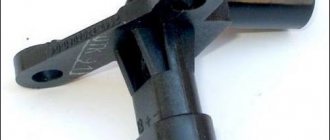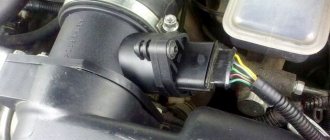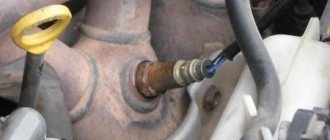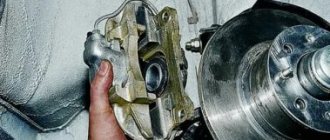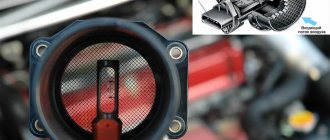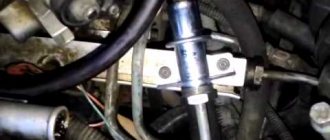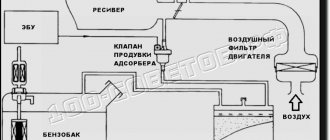On a VAZ-2110 with an injector, the crankshaft speed of the power plant at idle is maintained by the XX (IAC) regulator. The task of this regulator is to stabilize and maintain crankshaft speed at a given level under different conditions - abruptly releasing the gas pedal, creating a significant load on the on-board network (when the heater, headlights are turned on, etc.). A malfunction of the VAZ-2110 idle speed control does not affect the performance of the engine, but the lack of idle speed causes a number of inconveniences when operating the car.
What is an idle speed regulator (sensor)
The product in question is called both a sensor and a regulator (more correctly), and also less commonly a valve. Abbreviated as DXX, RXX. On the VAZ 2110, the idle speed sensor, like on the 2112, is installed with N according to catalog 2112-1148300.
The cost of the IAC is about 400–600 rubles, it is supplied to Prioras, Kalinas, Tavrias, Lanos and Sensas - checks and maintenance of the parts are similar.
You can change the idle speed sensor on a VAZ 2112 by unscrewing the two retaining screws. The valves are always located as standard on the rear of the intake manifold.
The idle speed sensor on the VAZ 2110 is a small valve assembly for measuring and actuating direction. However, despite its small size, if the regulator is faulty, serious disturbances in the functioning of the internal combustion engine are observed: more fuel is consumed, power decreases.
Replacement
All work is carried out in this order:
- Remove the negative from the battery.
- Disconnect the connector from the sensor.
Remove the block by pressing the plastic lock. - Remove the two bolts that secure the sensor.
Unscrew the bolts with a Phillips screwdriver. - Remove the regulator.
Old sensor. - Replace it with a new one.
- Assembly work is carried out in reverse order.
The calibration of the operation is carried out by the relay. It automatically adjusts the sensor when the ignition is turned on. After replacement, the engine speed should not fluctuate at idle.
» data-lazy-type=»iframe» src=»data:image/gif;base64,R0lGODlhAQABAIAAAAAAAP///yH5BAEAAAAALAAAAAABAAEAAAIBRAA7″>
How IAC works, tasks
Functions, operating algorithm of idle air valves:
- The functional task is the dosage of air supply. When the intake damper is fully open, and the electronics (ECU) detects the need to force idle speed, the IAC changes the location of its valve in the inlet opening in the shape of a thick needle or a long cone.
- This way the volume of incoming air is regulated. Moving, the rod creates the desired gap.
- A path with the required width is created for the air to bypass the throttle and then mix with the fuel.
- The result is that the engine does not stall.
In more detail, the work of the IAC looks like this. If the engine starts in cold weather, the ECU activates the valve to open the intake port, simultaneously supplying a larger volume of fuel for combustion. The revolutions increase, the heating of the internal combustion engine is accelerated. When the operating t° for the auto power plant is reached, the IAC stepper motor moves the closing cone forward. The air flow is reduced, the intensity of the stroke drops.
The VAZ 2112 idle speed sensor stabilizes it and levels it out, preventing jamming by dosing air when the intake valve is closed.
Purpose and design
The idle speed sensor (VAZ “injector” 1.6) is a device that controls the idle speed of the engine. With its help, the internal combustion engine can maintain optimal modes during operation, thereby increasing the service life of all its components. In addition, idling speeds can warm up the engine to operating temperature during cold periods. Thus, the idle speed sensor (including VAZ 2110) plays an important role in the operation of the vehicle’s internal combustion engine. By the way, it consists of only three components:
- Spring.
- Stepper motor.
- A rod with a conical needle at the end.
A more detailed design of this element is shown in the picture below:
As you can see, the structure of the DXH is very simple, therefore, the repair and replacement of this device can be handled with your own hands.
Idle speed sensor design
Composition of IAC:
- a small electric motor with a stepper type action;
- a rod with a calibrated thick needle-shaped cone and a spring;
- terminals for the block.
How to change a part?
Replacing the throttle position sensor in a VAZ of the “tenth” family and Lada Priora is quick and easy. But there is one question - what type of sensor should I choose? The fact is that new contactless elements of increased reliability and equally high cost have appeared on the market.
They do not contain a resistive film, and use the principle of magnetic induction to operate. So, if possible, it’s better to put one in your “top ten” and forget about the troubles with TPS for a long time.
The replacement operation is performed as follows:
- Disconnect the battery and disconnect the sensor from the connector.
- Unscrew the mounting bolts and remove the part. Don't lose your foam pad unless you have a new one.
- Install the new element with gasket and connect all wires.
If diagnostics and replacement are carried out correctly, then engine operation should stabilize in all modes.
Hi all! I hope the information from this post will be useful and will be useful to someone! Good luck on the roads and a full tank!
The “symptoms” of a faulty throttle position sensor include the following:
1. Increased idle speed. 2. The engine stalls in neutral gear. 3. Idle speed floats. 4. Jerks during acceleration. 5. Deterioration in dynamics. 6. In some cases, the Check Engine light may come on.
Diagnosis of the throttle position sensor is carried out as follows:
1. Turn on the ignition, then check the voltage between the slider contact and the minus with a voltmeter. The voltmeter should show no more than 0.7 V. 2. Next, turn the plastic sector, thereby fully opening the damper, then measure the voltage again. The device should show at least 4 V. 3. Now turn off the ignition completely and pull out the connector. Check the resistance between the slider contact and any terminal. 4. Slowly, turning the sector, monitor the voltmeter readings. Make sure that the needle moves smoothly and slowly; if you notice jumps, the throttle position sensor is faulty and must be replaced.
Replacing the throttle position sensor:
1. Disconnect the wire from the “–” terminal of the battery. 2. Disconnect the block with wires from the throttle position sensor by pressing the plastic latch. 3. Unscrew the two mounting screws and remove the throttle position sensor from the throttle pipe. 4. Install the new sensor in the reverse order, but do not forget about the foam ring. The throttle position sensor does not require any adjustment, since the controller perceives idle speed (i.e. completely closing the throttle valve) as zero. A faulty idle speed sensor can be attributed to the following:
1. Spontaneous unregulated change in engine speed (sudden decrease or increase). 2. When turning on a “cold” engine, there is no increase in speed. 3. When using additional vehicle devices (heater, headlights), the idle speed is simultaneously reduced. 4. The engine stalls at idle and when shifting gears. It is necessary to remember that the readings of the VAZ 2110 injector idle speed sensor are not “readable” by the automatic on-board power system, and it is not integrated into the “Check Engine” alarm system.
Diagnostics of the idle speed controller is carried out as follows:
There are several ways to analyze the idle speed sensor, but the main ones - the simplest and most effective - are the methods described below:
1. First you need to “get” to the device, disconnect it from the connecting block of wires 2. Using the most common voltmeter, check for the presence of voltage - the “minus” goes to the engine, and the “plus” to the terminals of the same block of wires A and D. 3. Turns on ignition, and the received data is analyzed - the voltage should be within twelve volts, if less, then most likely there are problems with the battery charge; if there is no voltage, then you will have to check both the electronic control unit and the entire circuit. 4. Then we continue the inspection with the ignition on, and analyze terminals A:B, C:D one by one - the optimal resistance will be about fifty-three ohms; During normal operation of the IAC, the resistance will be infinitely high.
Where can I buy
Spare parts and other products for the car are easily available for purchase at auto stores in your city. But there is another option that has recently received significant improvements. You no longer need to wait a long time for a parcel from China: the AliExpress online store now offers the opportunity to ship from transshipment warehouses located in various countries. For example, when ordering, you can specify the “Delivery from the Russian Federation” option.
Follow the links and choose:
| Idle Air Control Valve for Jaguar XJ XJS Buick Land Rover Chevrolet GMC Rover MG Isuzu | Car Protective Film Clear Film to Protect Bumper and Body from Scratch | IAC with two bearings for A/M VAZ 2110-2112 |
| Car Scratch Removal Applicator | Transparent ceramic coating for car | 12V 150PSI Rechargeable Tire Air Pump, Cordless |
VAZ-2112 sensors 16 valves and their location: diagram, photo, video
The efficient operation of the injection engine is ensured by a set of sensors. They all connect to the ECU. Lada hatchbacks of the 2112 family were produced only with injection engines, and two varieties of these internal combustion engines are 16-valve. We will talk about them further. All VAZ-2112 sensors, their location and appearance will be shown in the photo.
The excess oil pressure sensor, which is not connected to the ECU, is shown in the video.
Understanding the oxygen sensor
It is necessary to determine the sensor articles not by the engine model or even by Euro standards, but only by the ECU unit.
The number of oxygen sensors can be two or one - it all depends on environmental standards. AvtoVAZ also used two types of sensors - 0 258 005 133, 0 258 006 537 (BOSCH part numbers). The first of them are compatible with BOSCH M1.5.4, MP7.0 and January 5.1 controllers. Newer sensors were connected to the BOSCH M7.9.7 ECU (January 7.2). The two different types of sensors differ even in appearance.
The ECU unit in “Dozens of VAZs” is located under a plastic cover. It is located near the front passenger's foot.
The red arrow marks the first, that is, the main sensor. The top photo corresponds to engine 21124 (1.6 l).
VAZ-21120 engines (1.5 l) could meet the Euro-3 standard, and then an “extended” catalyst was welded behind the main sensor. The second sensor was located behind it, that is, behind the “can”. Let's clarify:
- The Euro-2 standard corresponds to a design with one sensor (main);
- During the transition to Euro-3 standards, a second sensor was added (blue arrow).
By the way, the 24th engine can meet Euro-4 standards.
Main set of sensors for 16-valve VAZ-2112 engines
The ECU must control many parameters at once
The most important information will be the position of the crankshaft. You can turn off all sensors except the DPKV, and this will not lead to the engine stopping
Let's list all the elements one by one:
Let's take a look at how all the elements look in real life. Shown are pictures of VAZ-2112 sensors (16-valve internal combustion engine).
Everything said above is true for two engines at once - for units 21124 and 21120 (1.6 and 1.5 l).
You cannot unscrew the DTOZH sensor without draining the coolant. And to disconnect the sensor means to disconnect the connector, but not to dismantle the sensor itself.
Where is which sensor located - engine compartment diagram
Let's look at another picture.
It is important to understand where the following elements are located:
- DPKV;
- Lambda probe;
- Speed sensor;
- RXX;
- TPDZ;
- DMRV;
- DTOZH.
The location of the phase sensor is indicated in the previous chapter.
Never unscrew the speed sensor. It will be difficult to install it in a way that maintains a seal.
Articles
For oxygen sensors, the designation 21120-3850010 was first used. Then an article appeared with the numbers 1118 (see photo). It appears to be a new type of sensor. It will be easier to use BOSCH articles.
We list the article numbers of the remaining sensors:
- Mass air flow sensor (21124 or 21120): 21083-1130010-01, -10, -20;
- Mass air flow sensor (motor 21120 with ECU January 4.1): 2112-1130010, -01;
- DPDZ: 2112-1148200;
- РХХ: 2112-1148300-02;
- DPKV: 2112-3847010, -01, -03, -04;
- DTOZH: 2112-3851010, -01, -02, -05;
- Speed sensor: 2110-3843010-13, -18;
- DPRV: 2112-3706040, -02, -03;
- DD: 2112-3855020, -01, -02, -03;
- Oil pressure sensor: 2106-3829010, -01, -02;
- Antifreeze level sensor: 2110-3839310-10, -11, -12, -13, -14;
- Coolant temperature indicator sensor: 2101-3808600, -02, 2106-3828010.
The last three sensors are not connected to the ECU. However, a rough road sensor (2123-1413130) can be connected. It affects the operation of the engine, although it is attached to the body.
Engines with ECU January 4.1 do not have oxygen sensors.
In general, on VAZ-2112 hatchbacks, sensors may be different from those indicated in the list. But then we are talking about an 8-valve engine. And everything that we indicated applies to 16 valves, here is a diagram of this engine.
carfrance.ru
Signs of inoperability of the idle speed sensor
Failures of the idle speed sensor 2112 relate to the electrical or mechanical parts of the device. Signs of malfunction:
- main symptoms: do not hold (“float”), intermittent, weak idle, the vehicle stalls at it, and also when driving in “neutral”, when the throttle valve is retracted, it stalls;
- It is impossible to start in a cold state without opening the damper (until the gas is pressed). On a cold unit, increased speeds are not observed at all; damping occurs after the gear is deactivated when the vehicle is moving;
The symptoms are identical to those for the TPS, but for the latter “CHECK ENGINE” is displayed; if this signal is observed, then it is the one that is broken. The location where the idle speed sensor is located must be distinguished from the location of the TPS.
Signs of IAC malfunction
Unfortunately, the 2110 VAZ DXX is not equipped with a self-diagnosis system, so the “CHECK ENGINE” light signal will not indicate a malfunction. Loss of performance on the VAZ 2110, 2112 is determined by the following main features:
- the engine “stalls”, for no apparent reason, at idle;
- idle speed “floats”;
- when a “cold” VAZ 2110, 2112 engine is started, there is no increased speed at all;
- The engine stalls, namely, after turning off the gear while driving.
The symptoms completely coincide with the failure of the VAZ 2110 TPS, but in the case of this sensor the “CHECK ENGINE” indicator will light up.
Checking the functionality of the idle speed sensor
You must identify the breakdown manually - there is no self-diagnosis. The idle speed regulator of the VAZ 2110 is located in the intake after the valve (throttle body).
First, analyze the electrical part with a multimeter:
- The pinout of the IAC VAZ 2110 is being studied (available in the product instructions or on the Internet).
- They check whether the sensor is powered normally, for which it is disconnected and the block is removed.
- They take measurements of the two outer terminals on block A and D: Turn on the ignition, turn the multimeter to “continuity”, the black probe to ground (on the body itself) of the internal combustion engine, touch the positive (red) contacts one by one. A value within 12 V is normal. If not, the circuit is broken, the ECU is broken, the battery is discharged. This means we check the integrity (contacts, wires), the ECU (at pins 4 and 54 the norm is also 12 V), and the battery. If they are working properly, the problem is in the valve;
How to check the sensor?
If you have a tester, checking is easy:
- Set the VAZ 2110 to the handbrake;
- Disconnect the IAC connector to check;
- Check the voltage of the VAZ 2110, 2112 sensor circuit, while connecting the “minus” to the engine, the “plus” to the removed block, namely to terminals A: D (marked on the block, you can see the diagrams);
- The ignition is turned on and the readings given by the idle speed regulator are checked, which should be about 12 V. The value will be less - most likely the battery is discharged. When there is no voltage, it is necessary to check the entire circuit, and then the electronic control unit. There are no malfunctions, which means the circuit is working - the IAC installed on VAZ 2112 engines and other modifications are checked;
- The tester terminals are connected to the block, the circuit is as follows - first to terminals A: B, then to C: D. The resistance should be within 53 Ohms;
- Next, pairs A: C, B: D are checked - in this case, the resistance on a working product will be infinitely large.
When, as a result of these checks, the sensor reveals a discrepancy in the readings, it should be replaced. Also, the inoperative state of these VAZ 2110, 2112 engine sensors, in the unscrewed position, can be checked by attaching a block to them, then you need to turn on the ignition.
When the power is connected to the working product, the rod with the needle will change position. No changes will occur on a broken sensor. If a breakdown of the idle air regulator is detected, of course, it must be repaired. But there is no need to rush to a car service center - you can do the repairs yourself, saving money and time. But first, in general, it is worth cleaning the IACs; often after this they return to “life”.
Diagnosis of IAC mechanics
The mechanics may be broken. The main thing that is checked during diagnosis is the mobility (length) of the bolt cone. The 100% condition of the device can only be determined with a special stand or a special tester, but an eye check can also reveal the cause of the problem.
Checking the sensor for mechanical service involves removing it. Procedure:
- We put the vehicle in handbrake.
- Remove the “–” terminal from the battery.
- Disconnect the block from the valve.
- We clean, wipe the place where the product was located, the fastenings.
- Unscrew the fasteners and remove the part.
Instructions on how to check the idle speed sensor on a VAZ 2110 (injector, 8 or 16 valves) after removing it:
- We connect the sensor to the block.
- We connect the battery.
- We activate the ignition - the cone shutter should move forward. If this is not observed, there may be a malfunction of the rod (possibly coking) or the motor. The norm for the protrusion of the needle (cone) from the body of the product is 23 mm. When operational, if power is supplied, the rod changes position.
Symptoms of sensor failure
The reliability of the vehicle's fuel system during idling directly depends on the condition of the regulator. The VAZ 2112 does not have an electronic self-diagnosis system, which is why no warnings about any malfunctions are displayed on the dashboard. The presence of a defect can be determined by the following symptoms:
- after the engine warms up, the number of revolutions does not increase;
- the engine suddenly stops working;
- smooth revolutions during idle;
- the car starts poorly, even when you press the gas pedal;
- when you turn on devices that consume a large amount of energy (headlights, stoves, radios, etc.), the speed decreases;
- The engine stalls if neutral is engaged or when changing gears while driving.
If the listed symptoms appear, we can conclude that individual parts in the XX sensor are faulty or a layer of rust has appeared on them. Then it needs to be replaced.
Device testing methods
To test the cold speed sensor for functionality, you need to disconnect the plug with cables from it and connect the multimeter to voltmeter mode. Next, the voltage supplied to the IAC is checked.
The negative probe of the tester is connected to ground (engine body), plus to the removed block to terminals A and D. After turning on the ignition, the values produced on the XX sensor are checked; the voltage should not be lower than 12 V.
For lower values, the cause may be a discharged battery; the absence of voltage indicates an open circuit.
First, the electrical circuit as a whole is checked, then the control unit. If no faults are found, check the idle speed controller. Connect the terminals of a multimeter set to ohmmeter mode to the outputs of the block. The connection diagram is as follows:
- Initially, outputs A and B are checked, then C and D. If the device is working properly, the readings should be 53-54 Ohms.
- At the next stage, measurements are taken at outputs A and D, B and C. Resistance is close to infinite - this is the norm.
There is another way to check. The sensor is removed from the car and a block is attached to it. You need to press the needle with your finger and watch its movement. When the ignition is turned on/off, on a working device the needle begins to move.
Sometimes, to restore the functionality of the XX sensor, it is enough to remove it and clean it with special means, for example, carburetor cleaner in cylinders or WD-40. The product is applied to a cotton swab and the contacts are carefully processed. If there are a lot of oil stains and dirt, the entire throttle assembly is cleaned with the product. After cleaning, all parts should dry thoroughly.
How to remove and replace DHF: detailed instructions
If it turns out that the idle speed sensor is faulty, it must be replaced with a new one. The procedure for replacing the sensor is simple and even a novice car enthusiast can do it. You need to purchase a sensor in advance. For VAZ 2112, the IAC with article number 2112-1148300 is suitable.
It is better to purchase the product in specialized stores
When purchasing, you need to pay attention to the quality of the font and the presence of holograms to avoid counterfeiting. The rubber gasket on the original is reddish in color, the distance from the body to the tip of the needle should falsely be 23 mm
There should be no mechanical damage, gaps, or play on the part; all elements are securely connected.
To unscrew the fasteners you will need a Phillips screwdriver. The replacement process is a sequence of steps:
- First you need to de-energize the car by removing the negative terminal from the battery.
- Then press the plastic latch, disconnect the wire block and put it aside so that it does not interfere with work.
Then, using a screwdriver, unscrew the two bolts, but not completely. Finally, turn out the fasteners by hand so that they do not fall or get lost.
- Next, the faulty sensor is removed and the seat is cleaned of dust and dirt. So that they don't fall into the hole.
- Before installing a new device, lubricate the rubber seal with engine oil. The new IAC is inserted into the hole until it fits tightly.
The device is secured with bolts. Then connect the plug with wires and connect the battery.
After completing the procedure, calibration is performed. No effort is needed; all the calibration work is done by the electronic relay. You need to turn on the ignition and let the engine run for a few minutes.
After replacement and calibration, the turnover should be stable, not floating, either increasing or decreasing. The power unit must operate without failure. At idle, the crankshaft should rotate within 0.8 ± 0.05 thousand.
rpm
Replacing the idle speed sensor on a VAZ 2112
Cleaning DXX
You cannot ignore such a basic procedure as cleaning - this can give results, since sometimes parts of the product, contacts, become coked, covered with dirt and oil.
What you need for cleaning:
- cleaner (lubricant) WD-40 or similar cleaning products for equipment;
- cotton wool, clean rags, tampons.
Cleaning:
- The sensor is completely dismantled, with the block disconnected.
- The swab is moistened with the cleaning mixture. You can also spray the product with an aerosol.
- Carefully wipe the contacts, needle, and installation sites, especially if oil is found there.
Before installation, the regulator is dried, the protrusion of the needle from the body is measured (the norm is 23 mm).
If the sensor has a malfunction of the electrical part - the winding, the electric motor - then repair is impractical or impossible. They buy a new product, especially since it is not too expensive (on average 500–700 rubles, but can be found for 250–300 rubles).
If the problem is in the block with wires (you can buy a new one), loose contacts or contamination, then repair is advisable. Repair also makes sense if there are serviceable parts of an identical product - you can disassemble it and try to replace these parts. But we must take into account that usually such a repaired device breaks down more often and the inconvenience caused by this will be very unpleasant, so it is usually more profitable to immediately buy a new product.
Causes of failure. Node check
The reasons for the malfunction of the XX regulator are breaks in the electrical winding. engine and needle jamming due to dirt or corrosion. But the sensor is not always the “culprit” for missing idle speed. Therefore, before removing and checking the sensor, check its power supply circuit.
For all checks you will need a multimeter. The power circuit is checked with a device set to “voltmeter” mode. Diagnostics is simple - we disconnect the block with wires from the regulator, connect the “negative” probe of the multimeter to ground, and the positive one to the terminals marked with the letters “A” and “D”. With the ignition on, we take measurements. If the circuit is working properly, the readings should correspond to the rated voltage of the circuit. If there is no voltage, you should check the computer and relays responsible for powering the sensor.
Replacing and calibrating a new IAC
Replacing the idle speed valve sensor on a VAZ 2110: the part is inserted, the screws are tightened, the leads are connected according to the diagram (available in the instructions for the IAC or on the network). The idle speed control of the VAZ 2112 has 16 valves and on other vehicles with a power system of a similar design, it is located in the same standard way.
It is highly advisable to calibrate the IAC after replacement:
- Ignition for 7–10 seconds, without starting during this time.
- Start the internal combustion engine. Jumps and increased speed may be observed.
- Turn off the engine - the rod will move to another extreme position.
- Repeat the described steps 2-3 times.
- Run the engine for approximately 5–7 minutes.
It must be remembered that the calibration is reset after disconnecting the IAC or after removing the negative terminal from the battery. This procedure will help the speed “stand up” more correctly for better functioning of the system.
Operating principle of IAC VAZ-2110
Let's consider the principle of operation of the XX regulator. This element is part of the design of the throttle assembly, which dispenses the air entering the cylinders.
When the gas pedal is released, the throttle valve closes the main air intake channel. To ensure the engine operates in this position of the damper, an additional channel of small cross-section is made in the throttle body, through which air is supplied to the cylinders, bypassing the damper. The idle speed control is designed to change the cross-section of the additional channel, which allows the ECU to maintain speed regardless of conditions.
It all works like this: when the throttle valve is closed, the XX regulator slightly opens the bypass channel. Using the mass air flow sensor, the amount of air entering through the additional channel is determined. Based on this information, the ECU regulates the amount of fuel injected. Using data from other sensors, the control unit determines the crankshaft speed and, if they do not correspond to the norm, sends an impulse to the IAC in order to stabilize the engine operation by changing the channel cross-section.
The second way to check the IAC
You can also check the voltage that goes directly to the sensor:
- The negative probe of the multimeter is set to ground , the positive one - to terminals of block 1 and 4 . Then, when the ignition is turned on, the voltage at both terminals should show at least 12 Volts . If the value is less, then your battery is discharged, and if there is no voltage, then there is an open circuit.
Diagram of the test device for assembly
Which TPS sensor to choose for replacement
For stable and long-term operation of the sensor, we advise you not to buy too cheap analogues of questionable quality. The factory installed throttle position sensor was GM 2112-1148200 .
- DPDZ /2110/ GM 2112-1148200 price from 300 rub.
- DPDZ /2110/ PEKAR 2112-1148200 price from 200 rub.
- TPDZ /2110/ StartVOLT VS-TP 0110 price from 200 rub.
- TPDZ /2110/ HOFER HF 750260 price from 150 rub.
- DPDZ /2110/ CJSC Account Mash 2112-1148200-05 price from 400 rub.
- DPDZ /2110/ JSC RIKOR ELECTRONICS 2112-1148200 price from 300 rub.


